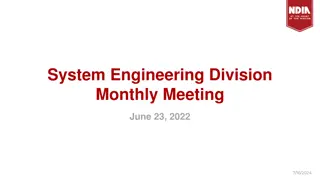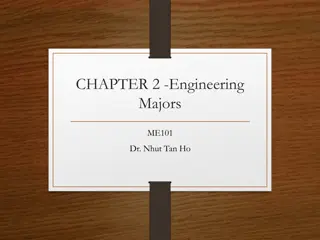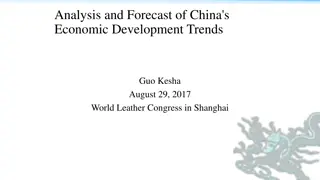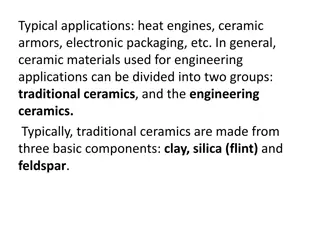Engineering Economic Analysis: Key Concepts and Applications
This presentation delves into the principles of engineering economic analysis, focusing on areas such as interest rates, inflation, and discount rates. It emphasizes the importance of considering financial aspects in engineering decisions and offers insights into evaluating costs and benefits over time. With contributions from notable experts in the field, the content provides valuable knowledge for students and professionals alike in understanding the financial dimensions of engineering projects.
Download Presentation

Please find below an Image/Link to download the presentation.
The content on the website is provided AS IS for your information and personal use only. It may not be sold, licensed, or shared on other websites without obtaining consent from the author. Download presentation by click this link. If you encounter any issues during the download, it is possible that the publisher has removed the file from their server.
E N D
Presentation Transcript
ECpE Department Economics of Distribution Systems Dr. Zhaoyu Wang 1113 Coover Hall, Ames, IA wzy@iastate.edu
Economics of Distribution Systems Acknowledgement: The slides are developed based in part on Electric Power and Energy Distribution Systems, Models, Methods and Applications, Subrahmanyan S. Venkata, Anil Pahwa, IEEE Press & Wiley, 2022 2 ECpE Department
1. Introduction Most engineering decisions require the commitment of financial resources. Some of these resources will be spent in the present, and more will be needed for the future. In addition, there could be benefits that accrue on an annual basis. Example: Consider a utility that decides to install capacitors in a distribution system to improve power factor and reduce losses. Costs: money to purchase capacitors and related hardware, and for their installation, and a certain amount of money annually to maintain the capacitors. Benefits: reduction in losses. As expenses take place over different years, we cannot simply add all the costs and all the benefits to obtain the net expenses for the project. This is because the value of money is not constant but decreases from one year to the next. We need to examine some of the factors that are commonly used in engineering economic analysis and arrive at simple approaches to determine costs and benefits of projects over a period of time. 3 ECpE Department
2. Basic Concepts 2.1 Interest Rate Interest rate is the rate that is applied to a financial transaction. The rate can be different, depending on the type of transaction. For example, if you deposit money in your checking account, you get a very small interest, but if you deposit the money in a certificate of deposit (CD), you will get higher interest. However, you will not be able to use the money that you deposited in a CD until it matures. Similarly, the interest rate that you have to pay to borrow money to buy a car is very different from the interest rate that you would pay to buy a house. The rates are different due to risks, flexibility, and other factors related to the transaction. 2.2 Inflation Inflation is the rate at which the price of goods and services increases with time. Inflation in fact is an integral part of the modern economy. It varies from one year to another and from one country to another. Nobody seems alarmed if inflation stays at a small value, but everyone gets worried if its value becomes very large. Inflation is a complex phenomenon, and its value at a given time depends on the spending behavior of people, policies of the government, international events, and many other factors. 4 It is almost impossible to predict inflation for the future years. ECpE Department
2. Basic Concepts 2.3 Discount Rate Discount rate is the rate that is used by businesses to discount money with time to make financial decisions that span several years. Different businesses use different discount rates based on their specific conditions. Discount rate are often related to the opportunity cost of investing capital. Investor perspective: $100 today $112 in a year 12% discount rate. Discount rate is usually much higher than the interest rate that you would get from the bank since it includes risk, cost of capital, government policies, and other business factors. Generally, the discount rate used for engineering economic analysis does not include the effect of inflation. However, if inflation rates for future years are available, they can be included in the discount rate. If the discount rate does not include inflation, all the future costs and benefits are represented in real dollars (today's dollar), but if they do include inflation, then all the future monies are represented in inflated or nominal dollars. It turns out that either way the results are the same. Therefore, most people prefer to leave inflation out to keep things simple. 5 ECpE Department
2. Basic Concepts 2.4 Time Value of Money Money loses value with time. The more the investor waits to receive the money, the higher the amount he will expect. Financial analysis converts all the future financial outlays to a present value by defining the present worth factor or discount factor, given as a function of discount rate (d) and years from present (n): 1 ???= 1 + ?? A discount rate of 12% and n = 1 gives a present worth factor of 0.893, which implies that $100 one year from today will have the present worth of $89.30. Similarly, n = 5 with the same discount rate gives a present worth factor 0.567, and therefore, $100 five years from today have a present worth of $56.70. 2.5 Annuity Annuity is a term that defines equal financial outlays that occur at fixed interval of time. For example, if we take a loan for three years from the bank to buy a car, we will be paying the bank a fixed amount of money every month for the following three years. The amount of payment will depend on the amount of loan and the interest rate. Similarly, in engineering applications, the same amount of expense or benefit may take place on a yearly basis, such as annual cost of maintaining equipment and annual benefits accrued due to the implementation of a new technology. 6 ECpE Department
2. Basic Concepts 2.6 Present Worth of Annuity An annuity of $? over ? years can be converted to the present worth by first finding the present worth of the financial outlay for each year and then summing the present worth, ? ? ? ??(?)?= (1+?)+ (1+?)2+ + (1+?)? We have considered that payments for each year are made at the end of the year. Now add and subtract ? from the right-hand side of this equation and let 1 (1+?)= ?. Then, ??(?)?= ? 1 + ? + ?2+ + ?? ? 1 ??+1 1+?. The quantity within the parenthesis is a finite geometric series equal to Upon substitution and simplification, we get ??(?)?= ?(1+?)? 1 ?(1+?)? 7 ECpE Department
2. Basic Concepts 2.7 Present Worth of Geometric Series In some situations, certain quantities will increase at a certain rate annually. An example of such a quantity is losses in distribution feeders. Since losses are dependent on load, and if the load grows at a certain rate, the losses will also grow annually. With ? as the rate of load growth, we get a geometric series, ??= ?? 1(1 + ?)for? = 2to? where ?? is the cost due to losses in year ?. The present worth of such a series over ? years with the total cost at the end of the first year equal to ? is ??(?)?= ? ? + ?2(1 + ?) + ?3(1 + ?)2+ + ??(1 + ?)? 1 or ??(?)?= ?? 1 + ? + ?2+ + ?? 1 where ? = ?(1 + ?). 1 ?? 1 ?. Substituting this in the above expression and simplifying Now, the quantity within the parenthesis is gives ? 1+? 1+? ? 1 ??(?)?= (? ?) 8 ECpE Department
3. Selection of Devices: Conductors and Transformers Economics is one of the major factors in the selection of devices and equipment for distribution systems. The decision should include the total cost including the capital cost, the operating cost, and the cost of losses over the selected life of the equipment. Focus of this section: Conductors for distribution feeders and distribution transformer selection. 3.1 Distribution Feeder Conductors The selection of conductors for design and upgrade of distribution systems is an important part of the planning process. After taking all the factors into consideration, utilities select four or five conductors to meet their requirement, which is done based on life cycle economic analysis and engineering judgment. Historical factors also play a role in the selection process, i.e., if a company has been using a particular size of conductor, they would want to continue to use that size unless there are compelling reasons not to do so. Some of the important factors to consider are conductor ampacity, conductor resistance, feeder cost, power cost, energy cost, and load growth. 9 ECpE Department
3.1.1 Conductor Economics Every conductor has a unique cost vs. load characteristic. Thus, for the proper selection of conductors, it is necessary to analyze these characteristics. Initial installation, annual operation and maintenance, and losses are the three components of the total cost. Initial installation is a one time cost, and it is incurred whenever the line is built. This cost is different for different conductor sizes since heavier hardware is needed for larger conductors, and also the handling cost is higher for larger conductors. Annual operation and maintenance costs are also higher for lines with larger conductors. This is mainly due to the fact that utilities would spend more money on maintenance of those lines that carry higher load since the failure of these lines would impact a larger number of customers. The present worth of fixed annual expense of $A/year for operation and maintenance over a period of N years at a discount rate of d can be determined by multiplying it by the present worth factor. 10 ECpE Department
3.1.1 Conductor Economics Unlike transmission systems, the feeders and distribution systems are not transposed. Thus, each phase has a different resistance and reactance value. However, for planning purposes, it is prudent to consider them to be equal to simplify computations. Option 1: consider the feeders to be transposed and determine the phase impedance matrix. In the next step, transform the matrix to sequence matrix and use the positive sequence resistance and reactance in the calculations. Option 2: consider the feeders to be transposed and determine the phase impedance matrix. In the next step, transform the matrix to sequence matrix and use the positive sequence resistance and reactance in the calculations. 11 ECpE Department
3.1.1 Conductor Economics Losses in the lines, which are a function of the peak load, contribute to the variable part of the cost. If there were any load growth, this cost would increase every year. Thus, if the peak load in the first year of operation of the line is P MW, losses due to this load can be computed by first determining the current, which is ? 103 3 ? ??A I = where V is the line-to-line voltage in kV, and pf is the power factor. For an annual loss factor (ratio of average loss to loss at peak load) ?sf, the total energy losses in the first year for one mile of a three-phase line with a resistance of r ohms per mile are, 8760 103????2? (???)2 Loss1= 3?2? = kWh/mile = ??2$/mile where ? =8760 103?s? is a constant for the given values of various quantities. (??)2 12 ECpE Department
3.1.1 Conductor Economics Multiplying the previous equation by c (cost of energy in $/kWh ) gives the cost of losses in $/ mile for the first year. Now, consider that peak load grows at a rate ? per year. Therefore, the peak load in the ?thyear is given by, ??= ?(1 + ?)? Therefore, losses in the ?thyear (Lo???) with the peak load of ?? and the assumption that all the quantities in ? are fixed are = ???2= ??2(1 + ?)2? = ??21 + ?2+ 2?? Loss? Now, if we let ? = ?2+ 2? Loss?= ??2(1 + ?)? = Loss1(1 + ?)? 13 ECpE Department
3.1.1 Conductor Economics Loss?= ????1 (1 + ?)? Losses will grow at a rate of j, while other terms in ????1 remain constant. Escalating quantities calculated using present worth factor from the expression of Present Worth of Geometric Series (as discussed in page 7). As a variation to this issue, we can consider that the load would grow at a certain rate for the first N years and then remain constant. Such a situation can be very easily included in the calculations by splitting the present worth calculation into two parts: First part: Present worth of geometric series for N years with load increasing at m per year. Second part: Present worth for remaining years with load set at Nth year's value. To obtain the total present worth, the cost of a line with a specific size of a conductor, we add the installation cost, the present worth of operation and maintenance, and the present worth of losses and obtain the following expression of the total present worth cost: ??Cost= ? + ??2$/mile ????O&M; ? =8760 103?sf ? ? PW2 where ? =???????+(??1 ) ; (? ??)2 14 ECpE Department
3.1.1 Conductor Economics ??Cost= ? + ??2$/mile ????O&M; ? =8760 103?sf ? ? PW2 where ? =???????+(??1 ) ; (? ??)2 CostO&M denotes Operation and maintenance cost in $/year/mile; ??1, present worth factor for fixed annual O&M cost/year; and ??2, present worth factor for losses changing yearly with changing load. Thus, the total present worth as a function of peak load in the first year turns out to be a quadratic function. 15 ECpE Department
3.1.1 Conductor Economics The present worth cost of lines of different conductor sizes, and when the total present worth cost vs. peak load characteristics of different conductors are plotted in the Figure. An important thing to note is that the plots of different conductors intersect with each other, and thus, for every value of peak load there is a conductor with the least cost. Hence, the peak load range for which a conductor is the most economical is defined as the economic loading range of that conductor. The economic loading range of Conductor 3 is plotted. The largest conductor in the set has a lower economic loading limit, but the upper economic loading limit is equal to the thermal loading limit of that conductor. 16 Figure: Economic characteristics of a set of four conductors. ECpE Department
3.1.2 Reach of Feeders The reach of a feeder built with conductors of a specific size is defined as the distance up to which a certain load can be delivered over the feeder without violating the voltage limits at the end of the feeder. Thus, we define the following reaches: Thermal reach of a feeder: the distance up to which the feeder can move power at its thermal loading limit (maximum allowed current) while maintaining the voltage within the specified limits. Economic reach of a feeder: the distance up to which the feeder is capable of carrying power equal to that determined by the upper limit of the economical loading range of the selected conductor without violating the voltage limits. The reach of a feeder with a specific conductor size at a given load is determined by first finding the voltage drop on the feeder for the current corresponding to that load. Assumption: the load is balanced and all the phases have the same impedance. The percent voltage drop per mile for a distribution feeder is obtained by dividing the voltage drop by the rated line to neutral voltage and multiplying the result by 100, i.e., 3?(?cos +?sin ) ? 1000 %?drop/mile= 100 where V is the rated line-to-line voltage of the system in kV. 17 ECpE Department
3.1.2 Reach of Feeders If the allowed voltage drop is ?V% , the reach, R, of the feeder is given by ( ?/100)? 1000 3?(?cos +?sin )miles ? = or, ? =( ?/100)?2cos ?(?cos +?sin )miles (1) Figure: Economic characteristics of a set of four conductors. When I = ????, the computed reach is the thermal reach, and when I = ????? or current corresponding to power at the upper limit of the economic loading range of the conductor, the reach is called economic reach. ?????: Current at intersection of selected conductor's curve with next higher conductor as shown in the Figure. This point gives the economic loading limit of the conductor; i.e., the conductor is not economical for use beyond this limit. If a reach higher than the economic reach is desired from a feeder, the feeder has to be derated, or the upper loading limit reduced to keep the voltage drop within the limits. In distribution system design, it is a recommended practice to keep the reach of all the feeders in a system the same by derating all the conductors in the selected set corresponding to the desired reach. 18 ECpE Department
3.1.2 Reach of Feeders Figure: Reach at different peak loads for selected conductors. A plot showing variation of reach (R) with peak load (P) for any given conductor and power factor can be obtained using: Note that reach must be computed using the final peak load on the feeder. For example, if a conductor has a certain peak load in the first year and it increases over the years to the final peak load in year N, the peak load in N must be used for reach calculation. The Figure shows reach as a function of peak load for four conductors. It is very obvious that reach decreases with increase in peak load. 19 ECpE Department
3.1.2 Reach of Feeders Figure: Reach at different peak loads for selected conductors. Now, if we desire a common reach for these conductors, we draw a horizontal straight line at the desired reach value, which is Rc miles in this figure. Intersections of the horizontal line at Rc with the reach characteristic of different conductors provide the maximum peak load of the respective conductors for the desired reach. Therefore, the maximum peak load for a common reach of Rc miles is Pmax1 for Conductor 1, Pmax2 for Conductor 2, Pmax3 for Conductor 3, and Pmax4 for Conductor 4. 20 ECpE Department
3.1.2 Reach of Feeders Now, we use the maximum peak load values obtained from Figure(a) and derate the conductors for a reach of Rcmiles to get the revised cost characteristics as shown in Figure(b). Figure(a): Reach at different peak loads for selected conductors. Since the cost characteristics are based on the peak load in the first year, the maximum peak load values from Figure(a) must be scaled down to the first year. For example, the maximum first year peak load for Conductor 1 will be ????1 1 + ?? Figure(b): Economic cost characteristics of a set of four selected conductors with a common reach of Rc miles. ?1= 21 ECpE Department
3.1.2 Reach of Feeders Similarly, we can obtain values of P2, P3, and P4. Because we are derating the conductors, the cost characteristics do not intersect each other any longer. Therefore, we see a jump from one conductor to the next at the peak loads P1, P2, P3, and P4. Figure(a): Reach at different peak loads for selected conductors. Although the most economical characteristics are those given by the graphs of different conductors in a conductor set, a straight line can be a simple linear approximation for these characteristics. This line could be a line tangent to the smallest and the largest conductor as shown in Figure(b). Note that the full graph of the largest conductor is not shown in this figure, but the straight line approximation does meet its graph at higher values of peak load. Figure(b): Economic cost characteristics of a set of four selected conductors with a common reach of Rc miles. 22 ECpE Department
3.1.2 Reach of Feeders Calculations shown in this section, as well as in the previous section, are for three phase feeders. The analysis can be modified for single or two phase feeders. Such modifications are important because a large percentage of feeders in a distribution system carry load below 1 MW, and often, these feeders are single phase laterals. Further, the voltage drop calculations were done with an assumption that the power flowing on the feeder remains the same at the beginning and end of the feeder. But in reality, the power flow decreases as we move along the feeder because the feeder will have laterals tapped off of it to supply loads. This in turn decreases the voltage drop or increases the reach of the feeder. A factor to account for the reduction in voltage drop for such phenomenon can be included in the calculations. Specifically, a precise value of this factor can be determined if the feeder serves a uniformly distributed load in a rectangular or triangular service area. However, in reality, these conditions do not exist. So computing a factor to account for reduction in voltage drop is difficult. On the other hand, it is alright if we do not consider this factor because, in emergencies, the feeders may be required to support the additional load of an adjoining feeder. The extra load and reach margin available on the feeders would be valuable in such situations. 23 ECpE Department
3.1.3 Optimal Selection of Conductors for Feeders Selection of a good conductor set is very important for proper planning of distribution systems. An ideal conductor set should have roughly equal economic loading range for each conductor, sufficient thermal capacity in the largest conductor to take care of situations with very high load, and should be the most optimal in terms of cost. Generally, it is very difficult to select a conductor set that will meet all the criteria of an ideal set. Most utilities choose conductors for their system based on experience and historical applications. Usually, the number of conductors in a set is limited to four or five for proper management of inventory. Some authors have addressed this issue to provide a systematic procedure for selection of a good conductor set. An approach to determine the optimal conductor is by minimizing the aggregate area under the plots of different conductor sets between the minimum and the maximum loads. For example, in the Figure on page 15, we would integrate from zero to the maximum value of annual peak load on the graph of the lowest cost characteristics considered for different load ranges. The conductor set with minimum value for this area would have an average minimum cost over the whole range of loading. 24 ECpE Department
3.1.3 Optimal Selection of Conductors for Feeders A simpler approach is to compute the area enclosed by the conductor curves and the tangent line to the smallest and the largest conductors in the set as shown in Figure(b), page 20. We call this line the ideal line. Also, the conductor characteristics shown in this figure account for derating of conductors to accommodate the selected feeder reach. During various studies we found that none of the conductors had plots that would go below the tangent line. Hence, minimizing the total area under the curves is equivalent to minimizing the area between the curves and the ideal line. The equation of the ideal line can be obtained by finding the two points where the ideal line would touch the smallest and the largest conductors in the set. These two points are given by the following equations: ?4(?1 ?4) ?1(?4 ?1) and; ?2=?1 ?1= ?4?1 where ?1= ?1+ ?1?2 and ?4= ?1+ ?1?2 are the equations of the smallest and the largest conductors in the set. Let the ideal straight line be: ? = ?? + ? ; 25 where m is the slop and c is the intercept on the y-axis. ECpE Department
3.1.3 Optimal Selection of Conductors for Feeders However, instead of using this area for the selection of the optimal conductor set, a better approach is to give different weights to areas in different loading ranges, since in most distribution systems a large percentage of feeders carry very small load, and a few feeders carry large load. For example, in a system discussed in [1], out of 24 800 miles of primary voltage line, close to 56% of the total length of feeders carry power less than 0.5 MW. Around 11% of the total length of feeders carry power between 0.5 and 1 MW. Similar information is given for every increment of 0.5 MW. Of these feeders, the ones that carry less than 1 MW are usually single phase laterals, and the remaining are three phase feeders. This shows that two thirds of the feeders in a distribution system are single phase feeders. These numbers are for an example system and will be somewhat different for different systems. A utility can very easily obtain such information from their existing system. 26 [1] Willis, H.L. (1997). Power Distribution Planning Reference Book. New York: Marcel Dekker, Inc. ECpE Department
3.1.3 Optimal Selection of Conductors for Feeders The table shows the percent of the total feeder length with the given peak load in an example distribution system in [1]. The modification included adjusting the percentage for each range to make the sum of the percentages equal 100. This table includes single phase laterals, it must be modified to determine weights to compute the weighted average deviation (WAD). Consider that a very small percentage of three phase feeders will carry peak load below 1 MW, we can discard the first two rows and scale up the percentages for the rest of the rows such that their sum is equal to 100. Following that, the WAD of the cost of a conductor set from the tangent line can be computed as follows: To explain this further, let P1 = 1.6 MW and P2 = 2.4 MW. Now, we want to compute the weighted area between Conductor 2 and the ideal line. Since the weights are given for 0.5 MW ranges, we divide the range of integration in 0.5 MW increments. Therefore, the weighted area between Conductor 2 and the ideal line is given by: The characteristics of Conductor 2 are given by y2= a2 + b2x2, where w2 is the weight for the loading range from 1.5 to 2 MW, and w3 is the weight for the loading range from 2.0 to 2.5 MW. The process is repeated for all the conductors in their respective loading ranges up to the maximum load of the largest conductor for the selected reach to determine the WAD. Table: Percentage of conductors with different loading ranges in an example distribution system. 27 [1] Willis, H.L. (1997). Power Distribution Planning Reference Book. New York: Marcel Dekker, Inc. ECpE Department
3.1.4 Example In this example, 17 conductors spanning from conductor #1 to 795 kcmil are considered for a 12.47 kV distribution system. The discount rate is 8%, the load growth rate is 0.5% over a period of 30 years, the loss factor is 0.46, the power factor is 0.9, the cost of energy is 3 cents/kWh, and the planning horizon is 30 years. The smallest and the largest conductors are preselected to be #1 and 795 kcmil, respectively, and the remaining two or three conductors are determined using the procedure described in the previous section. In Method A, the reach of the conductors is not considered for determining the optimal conductor set, and in Method B, a reach of 4.7 miles and allowed voltage drop of 7.5% are considered. The results for a four conductor set and a five conductor set are given in the Table. Table: Best conductor sets. Now, we want to compare the selected sets for a reach of 4.7 miles. To be able to do so, we have to derate the conductors determined with Method A appropriately. The adjusted average weighted deviations of the two conductor sets from the ideal cost characteristics are $17 049/mile and $15 160/mile, respectively, for the four conductor sets. Thus, the latter conductor set offers an average saving of $1889/mile for a reach of 4.7 miles. Similar analysis for the five conductor set gives WAD of $13 471/mile with Method A and $12 691/mile with Method B, thus yielding an average savings of $780/mile. 28 ECpE Department
3.1.4 Example When the common reach was changed to 3.6 miles, the same conductor set #1, 266, 477, and 795 kcmil were found to be the best whether Method A or Method B was used. This is a very interesting result, which can be explained as follows: We already know that to increase the reach of a conductor higher than its economic reach, the conductors need to be derated to carry maximum load lower than its economic loading limit. Thus, when the common reach is fixed at 4.7 miles after selecting the conductors, the conductors get derated significantly. This is because of the fact that the economic reaches of these conductors vary from 3.1 to 4.7 miles. So, when the reaches of all the conductors are adjusted to be 4.7 miles, all except one of them (266 kcmil, which has the economic reach of 4.7 miles) get derated by a large value. But when the reach is fixed at 3.6 miles, the conductors are not derated by a big margin, which implies a smaller deviation from the already selected characteristics. Hence, for smaller reach, the results are the same whether Method A or Method B is used. Also, the average weighted deviation from the straight line for a reach of 3.6 miles for the four conductor set turned out to be $10 633/mile, which is lower than that for a reach of 4.7 miles. This can again be explained by the fact that for a lower reach, derating of the conductors is lower than that for higher reach. Also, the optimal conductor set was found to be the same using both methods for the five conductor set, giving a WAD of $9317/mile. 29 ECpE Department
3.1.4 Example The results show that Method B is better than Method A if reach is known ahead of time. But both methods give the same result for shorter reaches. However, another question that needs to be answered is whether it is better to select five or four conductors. Five conductor set offers savings of $2468 over a four conductor set for a common reach of 4.7 miles. It offers savings of $1316/mile for a common reach of 3.6 miles. These savings can be very significant, since distribution systems are very extensive and cover large areas. However, extra cost associated with maintaining an inventory of five conductors in comparison to four conductors has to be considered while making decisions to stock four or five standard conductors in the inventory. 30 ECpE Department
3.2 Economic Evaluation of Transformers Similar to conductors, transformers have to be selected while considering both the capital cost and the operating cost. We use the economic principles presented in the previous section to determine the best size of the transformer. Transformer cost elements: Capital cost (Cc), Annual charge rate (Ar, which is inverse of the present worth factor), Annual operating expenses (OPEX). The expression for the total annual cost (???) of the transformer is given by, ???= ????+OPEX The annual operating cost includes the cost due to the exciting current ?ex, core losses ?cl, and copper losses ?cu. Therefore, OPEX = ?ex+ ?cl+ ?cu These costs can be estimated as follows: ?ex= ?exkVA?sc?? where ?ex is the per-unit exciting current of the transformer, kVA is the name plate rating of the transformer, and ?sc is the installed cost per kVAr of the primary shunt capacitors. 31 ECpE Department
3.2 Economic Evaluation of Transformers In other words, we are computing the cost of the capacitors needed to compensate the inductance caused by the exciting current in the transformer. ?cl= ?kW?r+ ?gen ?cl where ?kW is the cost of the investment per kW load, ?gen is the cost of energy generation per kWh,?cl are core losses of the transformer in kW, and are the number of hours/year or 8760 hours. ?cu= ?kW??+ ?pgen LsF ?2?cu where ?pgen is the incremental cost of the peak generation per kWh, LsF is the loss factor in pu, ? is the peak load of the transformer in pu, and ?cu are the copper loasses of the transformer at the rated load. Note that the cost of the core losses is treated differently than the cost of the copper losses. The core losses are constant at all loads, but the copper losses increase with increasing load. The index of the transformer is defined as: AC? kVA Economic Performance Index = 32 ECpE Department
3.2 Economic Evaluation of Transformers Example For a 100 kVA pad mount transformer, the data are given in theTable. Compute the total annual cost and the economic performance index of the transformer. Solution Total Annual cost: ACT = 3000 0.25 + 498.39 = $1248.39 Economic Performance Index = 1248.39/100 = $12.48/kVA Table: Data for a 100 kVA pad mount transformer. 33 ECpE Department
4. Tariffs and Pricing Unlike the transmission systems, which are regulated by the Federal Energy Regulatory Commission, distribution systems are regulated at the state levels. Electric distribution utilities have an obligation to serve all the customers in their service territory while maintaining a certain level of reliability. The utilities build, upgrade, and maintain the system to fulfill the obligation. The state corporation commissions allow utilities to include some of these expenses into the rate base. In other words, the utilities recoup these expenses over time through revenues collected through bills. Every state has a different model, but there are many common elements to the electricity bills, and we will explore them in this section. 34 ECpE Department
4.1 Electricity Rates 4.1.1 Energy Energy consumed by customers is measured in kilowatt hours (kWh) by a meter installed at the service entrance. The simplest form of rate charges for energy at a fixed rate irrespective of the time when it was consumed. For customers with large requirements, some utilities have block rates in which the first block of energy consumed has a rate and the next block of energy has a lower or higher rate. Subsequent blocks have lower or higher rates. 4.1.2 Demand Demand is defined as the largest power demand (kW) measured for a specified duration during the billing period. For example, customers on a typical demand rate will pay for the energy consumed over the month and will also pay for the maximum one hour demand during the month. The demand can be applicable for all the months or for certain months of the year. 35 ECpE Department
4.1 Electricity Rates 4.1.3 Time of Use (TOU) As the name implies, under this plan varying electricity rates for different blocks of time are usually defined for a 24 hour day. TOU rates generally reflect the average cost of generating and delivering power during those time periods. TOU rates often vary with the time of the day and by the season, which are typically predetermined by the utilities. This type of pricing requires meters that register cumulative usage during different time blocks. As an example, the utility can define 2:00 p.m. to 7:00 p.m. as the peak period with a higher rate for electricity. The rate for the off peak hours is lower than the flat rate to provide incentive to customers to sign up for this rate plan. In addition to the peak period, some utilities use three blocks of rates. These blocks are peak, shoulder, and off peak. Thus, the off peak period could be from 10:00 p.m. to 10:00 a.m., shoulder period from 10:00 a.m. to 2:00 p.m. and from 7:00 p.m. to 10:00 p.m., and peak period from 2:00 p.m. to 7:00 p.m. In certain cases, the TOU rates are applied only during the summer months. There are multiple combinations for time of use rates. Some utilities have implemented TOU rates and some have experimented with them, but they are not used very widely in the utility business. 36 ECpE Department
4.1 Electricity Rates 4.1.4 Critical Peak Pricing (CPP) This type of pricing includes a prespecified high rate for usage during periods designated by the utility to be the critical periods. The CPP events are generally triggered by system contingencies or high prices faced by the utility in procuring power in the wholesale market. CPP rates may be superimposed on either a TOU or time invariant rate and are called on a relatively short notice for a limited number of days or hours per year. CPP customers typically receive a price discount during non CPP periods. CPP rates have been tested in pilots for large and small customers in several states. While they have not been implemented at a wide scale, they are available to certain class of customers in some areas. 37 ECpE Department
4.1 Electricity Rates 4.1.5 Critical Peak Rebates (CPRs) Under this plan, the utilities give a predetermined amount of refund to the customers for reducing their consumption when they observe or anticipate high wholesale market prices or power system emergency conditions. The utilities may call critical events during prespecified time periods (e.g. 3 p.m. to 6 p.m. summer weekday afternoons). Although the price for electricity during these time periods remains the same, the customer is refunded for any reduction in consumption relative to what the customer was expected to consume. 4.1.6 Interruptible Rates These rates are available to large industrial, commercial, or government customers. Those under this plan agree to curtail their load by a certain percent under declared emergencies. 38 ECpE Department
4.1 Electricity Rates 4.1.7 Power Factor-Based Rates Since lower power factor results in higher current for the same amount of real power, some utilities charge large customers a penalty for low power factor. For example, the utility may require the customer to maintain the power factor between 0.95 lagging and unity. Deviations outside of that are assessed a penalty. 4.1.8 Real Time Price Real time price is commonly used in bulk power systems. For example, power pools such as Southwest Power Pool have the price of electricity in its systems declared every 5 minutes in real time. Such implementation has not been done in distribution systems. However, in the future, the FERC Order 2222 will allow third party aggregators to pool resources from customers in distribution systems and bid in the market. The resources would be in the form of customer owned solar or other generation and reductions in customers load in response to price changes. 39 ECpE Department
4.1 Electricity Rates 4.1.9 Net Metering Net metering is an idea that came into existence to address issues arising from individual customers owning their own generation, such as rooftop solar photovoltaic generation, and injecting the excess power generation into the grid. In the early days, the utilities compensated the customers at the same rate at which they were selling it to the customers. However, this arrangement was flawed because the rate that utilities charge includes not only the cost of generation but also the cost of delivery. In addition, the utility has invested in the infrastructure to deliver electricity to customers while maintaining a certain level of expected reliability. In this arrangement, they are not able to recover money for their investments. Hence, the new net metering rates in place compensate customers at the wholesale rate for electricity in the market. The compensation for a given month is credited in the same month or carried forward to the next month. Accounting for the load offset behind the meter by local generation is done in different ways: Some utilities may consider compensation for it at the full rate, while others may have a reduced rate. Some states are allowing utilities to charge a monthly fee in dollars per kW based on the capacity of the customer owned system. This is a complex and controversial subject with many variations, and it is still evolving. With increased number of homes owning their own generation and participating in the market through aggregators, net metering will evolve further. 40 ECpE Department
4.2 Understanding Electricity Bills The rates that a utility charges to its customers are approved by the state regulators of the state in which the utility provides services. Therefore, each utility has its own schedule of rates, and thus, no two utilities are identical in this regard even within the same state. While it is not possible to cover all possible billing options, we show an example of a typical utility bill based on the rates for residential customers given in the Table for a large utility company. Table: Example of rate schedule for residential customers. 41 ECpE Department
4.2 Understanding Electricity Bills Example Consider that a customer consumes 1125 kWh in the month of July. This customer has purchased RECs to buy electricity from solar facilities. Compute the monthly bill for this customer based on the rate schedule given in Table. The customer has also volunteered to purchase 500 kWh of electricity per month from solar resources and pay a surcharge of 2.055 per kWh. In addition to kWh usage, the utility has determined a fuel charge of $21.65 and taxes of $6.13. Since the month is July, we use the schedule to compute the cost for distribution and energy supply. Distribution:800 0.021086 = $16.86 325 0.011943 = $3.88 Generation: 800 0.035826 = $28.66 325 0.054500 = $17.71 Transmission: 1125 0.00970 = $10.91 Green Power: 500 0.020550 = $10.27 Monthly Bill = 7.28 + 16.86 + 3.88 + 28.66 + 17.71 + 10.91 + 21.65 + 6.13 = $113.08 Therefore, the average cost of electricity for this customer is 113.08/1125 = 10.051 per kWh. Table: Example of rate schedule for residential customers. 42 ECpE Department
4. Tariffs and Pricing 4.3 Rural Electric Cooperatives (RECs) United States is a large country with many rural communities. Since investor owned utilities were not catering to the needs of the rural communities, the government passed legislation in 1936, which resulted in the formation of RECs. The RECs are member owned nonprofit organizations that provide electricity to rural communities. Large RECs own their own generation and transmission, but smaller ones only engage in the distribution business. 4.4 Municipal Utilities Several small cities in the United States operate their own distribution system. Some of them own small generation within the city limits, but many of them buy electricity from the market to serve their customers. Since individual cities do not have large market power, typically several cities cooperate to form power purchase pools for better rates. 43 ECpE Department
Thank You! 44 ECpE Department

























